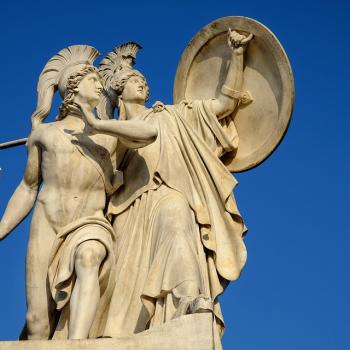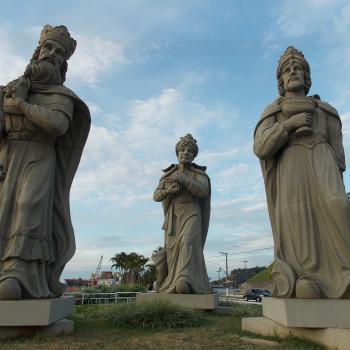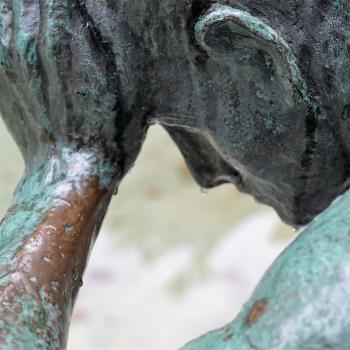We may wonder why all this Trinitarian fuss arises in the 4th century… 300 years after Christ. Why didn’t they figure all this out long before?
I don’t propose to give you 300 years of church history in this post, but let me give you some handles on those years that can help explain why the Creed was written when it was.
The first thing we have to recognize is that for most of those years, being a Christian could be risky business. We have a variety of Caesars who seemed to focus on helping Christians with their call to MORTIFICATION. One of the first to zero in on the Christians was Nero (54-68); some say Nero was quite mad. Perhaps, but that’s a poor excuse for blaming the Christians for burning down a large part of Rome (especially when he probably order the fire himself so that he could clear the way for some of his pet building projects). Here’s how the Roman historian Tacitus describes it, 50 years after the event:
Nero substituted as culprits, and punished with the utmost refinements of cruelty, a class of men, loathed for their vices, whom the crowd styled Christians. Christus, the founder of the name, had undergone the death penalty in the reign of Tiberius, by sentence of the procurator Pontius Pilate, and the pernicious superstition was checked for a moment, only to break out once more, not merely in Judea, the home of the disease, but in the capital itself where all things horrible or shameful in the world collect and find a vogue. First, then, the confessed members of the sect were arrested; next, on their disclosures, vast numbers were convicted, not so much on the count of arson as for hatred of the human race. And derision accompanied their end: they were covered with wild beasts’ skins and torn to death by dogs; or they were fastened on crosses, and, when daylight failed, were burned to serve as lamps by night.
It is probable that both Peter and Paul died in this wave of hostility. Paul probably had the less gruesome end, since he was a Roman citizen and therefore merited some more humane form of execution…probably beheading. Legend tells us that Peter, who was about to be crucified and did not feel worthy to die as had his Lord, asked to be crucified upside-down.
Nero was the first to attack the Christians, but he was by no means the last. We read of waves of persecution, sometimes localized, sometimes more widespread; sometimes systematic, and sometimes more hysteria-produced; sometimes aimed at church leaders, sometimes sweeping everyone who claimed the name of Christ before them. Christians’ property was confiscated, and they were mobbed, beaten, beheaded, torn apart by wild beasts, strapped to iron chairs and roasted, staked and gored, used as gladiator bait, and crucified. Needless to say, in light of all this, “theological epistemology” could hardly take the Christian world by storm.
This is not to say there weren’t great thinkers and writers during this period. We could spend some time with Justin Martyr (c. 100-165, guess how he got his ‘last name’), Irenaeus (115-202), Clement of Alexandria (160-215), Tertullian (160-220), Origen (185-251), and many others. Despite all that the church was going through, these great thinkers and theologians were all writing about God and Christian life and practice. But we still don’t see the great push to explore Trinitarian thinking until…
…Until finally Emperor Constantine flipped the persecution switch, turning it off completely with his Edict of Milan in 313. With that key political document, Christianity became a legalized religion with all rights and privileges.
At this point, we see the Church recognize that with its new public profile, it must take up the task of presenting the Christian faith to the world in a way that clearly and competently taught the truth. Christianity was taking its place in a pluralist world (not unlike ours), where multiple religions and philosophies and lifestyles ran rampant. How was Christianity going to present itself in a marketplace of ideas like that?
If, they said, we’re going to teach that we are monotheists and we’re going to teach that Jesus Christ is Lord, we are going to have to come to some way of understanding it ourselves.
Let me point out again that this new wave of thinkers was not inventing anything, but trying to capture in language what was already going on. This is how Anatolios puts it: “The church of the fourth century inherited a tradition of Trinitarian discourse that was pervasively embedded in its worship and proclamation, even if it was lacking in conceptual definition.” The church was already teaching Trinitarian ideas and worshiping a Trinity, but it had not yet come to articulate it in careful formula. The one formula everyone shared was the baptismal formula: We baptize you in the Name of the Father, and of the Son, and of the Holy Spirit.
Next up, another key reason that the 4th century leaders began to debate…heresy.
___________________________
Note to Reader: This series on Trinitarian Spirituality explores the history and spirituality behind the shaping of the Nicene Creed using Khaled Anatolios’ Retrieving Nicaea: The Development and Meaning of Trinitarian Doctrine (Grand Rapids, MI: Baker Academic, 2011) as guide and inspiration. It’s best to begin at the beginning: An Introduction.












